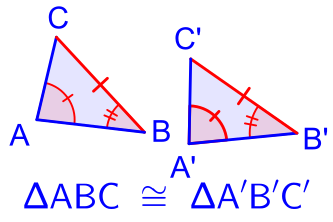
Back تطابق (هندسة) Arabic Ángulos congruentes AST Конгруэнтлыҡ (геометрия) Bashkir Еднаквост Bulgarian সর্বসমতা (জ্যামিতি) Bengali/Bangla Podudarnost (geometrija) BS Congruència (geometria) Catalan پێککەوتوویی (ئەندازە) CKB Конгруэнтлăх (геометри) CV Cyfathiant Welsh

In geometry, two figures or objects are congruent if they have the same shape and size, or if one has the same shape and size as the mirror image of the other.[1]
More formally, two sets of points are called congruent if, and only if, one can be transformed into the other by an isometry, i.e., a combination of rigid motions, namely a translation, a rotation, and a reflection. This means that either object can be repositioned and reflected (but not resized) so as to coincide precisely with the other object. Therefore two distinct plane figures on a piece of paper are congruent if they can be cut out and then matched up completely. Turning the paper over is permitted.

In elementary geometry the word congruent is often used as follows.[2] The word equal is often used in place of congruent for these objects.
- Two line segments are congruent if they have the same length.
- Two angles are congruent if they have the same measure.
- Two circles are congruent if they have the same diameter.
In this sense, two plane figures are congruent implies that their corresponding characteristics are "congruent" or "equal" including not just their corresponding sides and angles, but also their corresponding diagonals, perimeters, and areas.
The related concept of similarity applies if the objects have the same shape but do not necessarily have the same size. (Most definitions consider congruence to be a form of similarity, although a minority require that the objects have different sizes in order to qualify as similar.)
- ^ Clapham, C.; Nicholson, J. (2009). "Oxford Concise Dictionary of Mathematics, Congruent Figures" (PDF). Addison-Wesley. p. 167. Archived from the original on 29 October 2013. Retrieved 2 June 2017.
{{cite web}}: CS1 maint: bot: original URL status unknown (link) - ^ "Congruence". Math Open Reference. 2009. Retrieved 2 June 2017.
© MMXXIII Rich X Search. We shall prevail. All rights reserved. Rich X Search